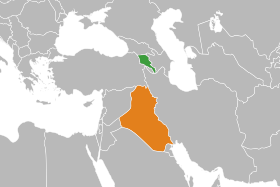 | |
| Total population | |
|---|---|
| 10,000 (2011);[1] about 20,000 prior to the 2003 invasion of Iraq | |
| Regions with significant populations | |
| Cities: Baghdad, Mosul, Basra, Kirkuk, Baqubah and Dohuk Villages: Avzrog, Havresk, Zakho and Ishkender[2] | |
| Languages | |
| Western Armenian[3] Mesopotamian Arabic | |
| Religion | |
| Christianity (mostly Armenian Apostolic, some Armenian Catholics and pockets of Evangelical and Brethren Protestants) |
| Part of a series on |
| Armenians |
|---|
 |
| Armenian culture |
| By country or region |
Armenian diaspora |
| Subgroups |
| Religion |
| Languages and dialects |
|
Armenian: Eastern (Zok) • Western (Homshetsi) Sign languages: Armenian Sign • Caucasian Sign Persian: Armeno-Tat Cuman: Armeno-Kipchak Armenian–Lom: Lomavren |
| Persecution |
Iraqi Armenians (Arabic: أرمنيون عراقيون ’Armanion Iraqion; Armenian: իրաքահայեր irakahayer) are Iraqi citizens and residents of Armenian ethnicity. Many Armenians settled in Iraq after fleeing the 1915 Armenian genocide. It is estimated that there are 10,000–20,000 Armenians living in Iraq, with communities in Baghdad, Mosul, Basra, Kirkuk,[4] Baqubah, Dohuk, Zakho and Avzrog.[5][6]
- ^ Armenia News.am website About 10,000 Armenians live in Iraq
- ^ "Armenians of Iraqi Kurdistan - Taking Up Arms Against the Ongoing ISIL Threat - Hetq - News, Articles, Investigations". Retrieved 24 September 2017.
- ^ "United Nations UNHCR website; An Iraqi Armenian teen shows the way to a new life".
- ^ Ashjian, Ara (12 August 2009). "Armenian Issues: From the Armenian Church of Iraq- A visit to the Armenian Community of Kirkuk". Retrieved 24 September 2017.
- ^ "Iraq: Tiny Ethnic-Armenian Community Survived Hussein, Making It In Postwar Times." RFE/RL. July 6, 2004.
- ^ Fisher, William B. (1978). The Middle East: A Physical, Social and Regional Geography. London: Routledge. p. 363. ISBN 978-0-416-71520-0.